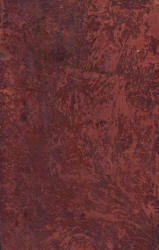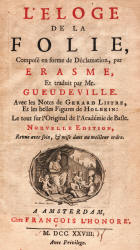
On the left, we show the non-contemporary, but antique,
binding to the 1728 edition of L'Eloge de la Folie.
On the right is shown the title page.

Moriae Encomium
The Praise of Folly; or, L'Eloge de la Folie
Illustrated by Hans Holbein the Younger
 |
On the left, we show the non-contemporary, but antique, binding to the 1728 edition of L'Eloge de la Folie.
On the right is shown the title page. |
 |
Moriae Encomium - known as The Praise of Folly (English); or, L'Eloge de la Folie (French) - was the work of the great Dutch
Renaissance Humanist and Theologian, Desiderius Erasmus. That work - written in the closing years of the first decade of
the 16th Century - was a satirical critique of both the Catholic Church and popular superstitions and was dedicated to his
friend, the English Renaissance Humanist, Sir Thomas More.
|
A copy of the First Edition of Moriae Encomium carries a suite of 81 designs that are among the earliest works by Holbein, having been produced around 1515 when he was still in his teenage years. That very year, Holbein had moved to Basel with his brother, Ambrosius, from his native Augsberg.
Holbein contributed illustrations to further early printed works, including Martin Luther's German translation of the Bible, in addition to other artistic works such as stained-glass installations and his seminal suite of illustrations known as Der Todten-Tantz (The Dance of Death).
The illustrations within the Collection are from an edition of L'Eloge de la Folie published by François L'Honoré (Amsterdam) in 1728. When presenting the etchings from plates based on Holbein's illustrations with associated text, we have shown the related English text provided in John Wilson's 1668 translation of Erasmus' work, in addition to the original French text from L'Eloge de la Folie (1728) - text which is claimed to be taken from an original copy held, at the time, by l'Académie de Basle. A comparative analysis of the translations is interesting and perhaps may provide cause, in itself, for further reflection on the theme developed by Erasmus. |
%20(250).jpg)
Above, we show a painting of Erasmus by Hans Holbein the Younger. |
Our Greeting Cards and Fine Art Posters
%20(sample).jpg) |
For connoisseurs, we have prepared sets of 81 Greeting Cards displaying each of the images from etchings of Holbein's designs for Moriae Encomium and on the left, we show an example of how these Greeting Cards appear.
Code: H ME MS(81) |
When presented on Greeting Cards, these images are prepared as tipped-on plates - in hommage to the hand-crafted
approach typical of prestige illustrated publications produced in the early decades of the 20th Century. Each card is
|
hand-finished and the images are presented on White card stock with an accompanying envelope. On the rear of each card we also present some information about this great work and each individual illustration. We have left the interior of the cards blank so that you may write your own personal message.
Should you wish to order a reproduction print of one or more of these images, we have provided some options on the pages highlighting individual images from L'Eloge de la Folie. Each of our Fine Art Posters is prepared with archival quality papers and inks - and also accompanied by information about this great work and the profiled illustration.
To purchase, simply click on the appropriate "Add to Cart" button and you will be taken through to our Shopping Cart secured through PayPal. Multiple purchases will be consolidated by that feature and shipping and handling costs to any destination in the world are accommodated by our flat-rate fee of US$20 for every US$200 worth of purchases.
Of course, should you wish to discuss some customised options, we welcome your contact on any matter through ThePeople@SpiritoftheAges.com.
In the meantime, however, enjoy perusing these wonderful images. |
An example of one of our Fine Art Posters in a superb 16x20" format |
Etchings to designs by Holbein for Moriae Encomiuim
.jpg) |
.jpg) |
||
|
Plate 1 (presented within-text)
|
Plate 2 (presented within-text) |
Midas' ears discover their master Plate 3 (presented as a folding plate) |
|
.jpg) |
.jpg) |
.jpg) |
.jpg) |
|
Plate 4 (presented within-text)
|
Plate 5 (presented within-text) |
Plate 6 (presented within-text) |
Plate 7 (presented within-text) |
.jpg) |
.jpg) |
.jpg) |
|
|
As plump and round as a Westphalian hog Plate 8 (presented within-text)
|
Plate 9 (presented within-text) |
Plate 10 (presented as a folding plate) |
|
.jpg) |
.jpg) |
.jpg) |
.jpg) |
|
Plate 11 (presented within-text)
|
Plate 12 (presented within-text) |
Plate 13 (presented within-text) |
The foolish child of a wise man Plate 14 (presented within-text) |
.jpg) |
.jpg) |
.jpg) |
|
|
Pulling off a horse's tail hair by hair Plate 15 (presented as a folding plate) |
A brazen statue in the marketplace Plate 16 (presented within-text)
|
Plate 17 (presented within-text) |
|
.jpg) |
.jpg) |
.jpg) |
.jpg) |
|
Plate 18 (presented within-text) |
Plate 19 (presented within-text) |
Plate 20 (presented within-text)
|
Plate 21 (presented within-text) |
.jpg) |
.jpg) |
.jpg) |
|
|
Fools, idiots, lack-wits, and dolts Plate 22 (presented within-text) |
Women are so earnestly delighted Plate 23 (presented within-text)
|
Plate 24 (presented as a folding plate) |
|
.jpg) |
.jpg) |
.jpg) |
.jpg) |
|
Plate 25 (presented within-text) |
Plate 26 (presented within-text)
|
Plate 27 (presented within-text) |
Plate 28 (presented within-text) |
.jpg) |
.jpg) |
.jpg) |
.jpg) |
|
Plate 29 (presented within-text) |
Plate 30 (presented within-text) |
The Jews expect to this day the Plate 31 (presented within-text)
|
Plate 32 (presented within-text) |
.jpg) |
.jpg) |
.jpg) |
.jpg) |
|
A pitiful painting viewed as if it were from Plate 33 (presented within-text) |
Plate 34 (presented within-text) |
Plate 35 (presented within-text) |
One who thinks there is no happiness Plate 36 (presented within-text)
|
.jpg) |
.jpg) |
.jpg) |
.jpg) |
|
Plate 37 (presented within-text) |
Plate 38 (presented within-text)
|
Plate 39 (presented within-text) |
Plate 40 (presented within-text) |
.jpg) |
.jpg) |
).jpg) |
.jpg) |
|
Plate 41 (presented within-text) |
Armed with mathematical devices Plate 42 (presented within-text)
|
Plate 43 (presented within-text) |
Plate 44 (presented within-text) |
.jpg) |
.jpg) |
.jpg) |
.jpg) |
|
They explicate the most hidden mysteries Plate 45 (presented within-text) |
Plate 46 (presented within-text) |
Plate 47 (presented within-text) |
They are so illiterate that they Plate 48 (presented within-text)
|
.jpg) |
.jpg) |
.jpg) |
.jpg) |
|
Plate 49 (presented within-text) |
As afraid to touch money as if it were poison Plate 50 (presented within-text) |
'Tis their only care that none of them come near another in their manner of living Plate 51 (presented within-text)
|
Plate 52 (presented within-text) |
.jpg) |
.jpg) |
.jpg) |
|
|
Niobe turning to stone as Apollo kills her sons Plate 53 (presented as a folding plate) |
Plate 54 (presented within-text) |
Plate 55 (presented within-text)
|
|
.jpg) |
.jpg) |
.jpg) |
.jpg) |
|
Plate 56 (presented within-text) |
Plate 57 (presented within-text)
|
Plate 58 (presented within-text) |
Plate 59 (presented within-text) |
.jpg) |
.jpg) |
.jpg) |
.jpg) |
|
Plate 60 (presented within-text) |
Plate 61 (presented within-text)
|
How soldier-like they bustle about Plate 62 (presented within-text) |
Plate 63 (presented within-text) |
.jpg) |
.jpg) |
.jpg) |
.jpg) |
|
Plate 64 (presented within-text) |
One who has least wit and most confidence Plate 65 (presented within-text)
|
The fat plump 'epicurean bacon-hog' Plate 66 (presented within-text) |
The soul of Scotus leaving the body Plate 67 (presented within-text) |
.jpg) |
.jpg) |
.jpg) |
.jpg) |
|
Plate 68 (presented within-text) |
Plate 69 (presented within-text)
|
Plate 70 (presented within-text) |
Plate 71 (presented within-text) |
.jpg) |
.jpg) |
.jpg) |
.jpg) |
|
The Theologian's Interpretation Plate 72 (presented within-text) |
Plate 73 (presented within-text)
|
Plate 74 (presented within-text) |
Plate 75 (presented within-text) |
.jpg) |
.jpg) |
.jpg) |
.jpg) |
|
Plate 76 (presented within-text) |
As if their minds lived elsewhere Plate 77 (presented within-text) |
One who relies wholly upon God Plate 78 (presented within-text) |
Plate 79 (presented within-text)
|
.jpg) |
.jpg) |
||
|
The life of holy men is nothing Plate 80 (presented within-text)
|
Wherefore farewell, clap your hands, live and drink lustily Plate 81 (presented as a folding plate) |
||